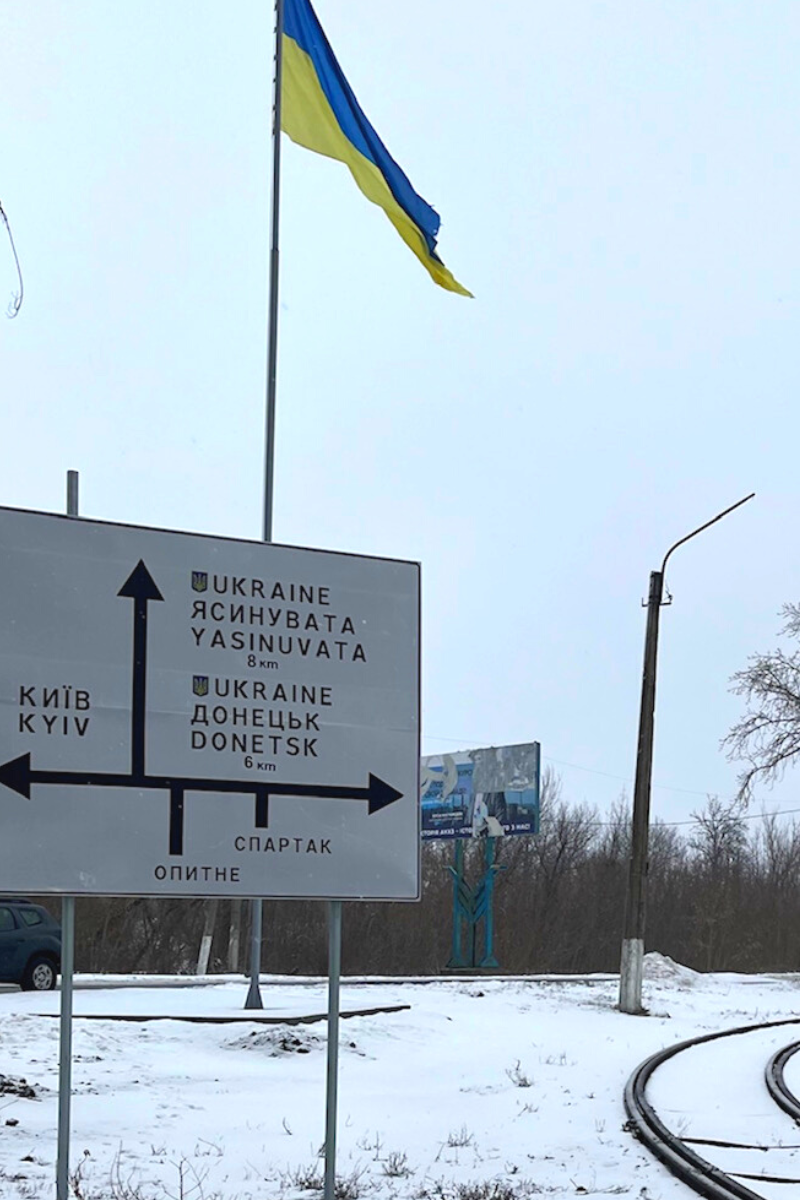KYIV, Ukraine – From many perspectives, Russia’s February invasion of Ukraine is already a gigantic failure. This is not only because of Moscow’s military mumbling and fumbling, but also because of Ukraine’s unconventional way of adapting commercially available technologies to a rather conventional war. From the outset, the conflict is largely influenced by grinding artillery battles. Yet, the assimilation of commercial, civilian-marketed technology and open-source intelligence has given Kyiv an edge against a much larger, robust, and highly equipped military force.
Moreover, the ongoing war inside the 233,030 square-mile country has emerged not only as a testing ground for new technology and weaponry but a real-time analysis of how wars will be fought in the near future. The Russian invasion is a classic story of how Ukraine (David) has put the commercial-off-the-shelf (COTS) pieces together to leverage its limited human resources and finances to change the odds against Russia (Goliath. From financial technologies to consumer technologies, Ukraine’s ability to improvise and adapt surprised nearly everyone.
Money First: Financial Tech
In the urgent aftermath of the February 24 invasion, the Kyiv government – embattled by central bank closures and the sudden onslaught of millions of citizens unable to withdraw critical funds to survive – turned to Blockchain-backed cryptocurrencies for donations. Analytics show that the government and high-profile non-governmental organizations (NGOs) supporting the military garnered more than $60 million in the first few weeks to support the purchasing of equipment and medicine for its armed forces.

In March, Kyiv announced it would fashion 54 Non-Fungible Tokens (NFTs) as part of its funding campaign, considered the world’s first NFT-centered “war bond.” Ukraine – already with a tech-savvy and crypto-curious population – steadily increased its transaction volume throughout the summer, data shows.
Smart Foundation: Ukraine’s Existing Software Industry
The vast majority of military analysts thought Ukraine would succumb to Russia’s invasion in a matter of weeks. They were proven wrong with the spirited defense of Kyiv by Ukraine’s much weaker but western-trained army and its sudden citizen-soldiers, who came from all walks of life. The war has underscored that it is not only the role of foreign governments – particularly western governments – to step up to the plate and respond, but that commercial and defense technology firms, with a ready population of software coders and tech workers, may have the most durable impact.
According to the Center for International Governance Innovation, the most critical developments are not necessarily the “flashy technological transformations that some futurists expected,” but relatively “incremental and focused” advancements.
A 2022 Global Skills Report by Coursera, a U.S.-based massive open online course provider founded in 2012 by Stanford University computer science professors, ranks the country among the top ten in technological abilities.
With these skills and the shocking imperative to innovate and “hack” war, Ukraine has been able to “punch above its weight” in the face of a bolder enemy, and its technology firms – large and decentralized ones – have twisted the balance of power.
Global tech giants have made serious contributions as well. Google has dished out support to Ukraine in different ways. For one, it occasionally turned off elements of its live-traffic locator maps to aid Ukraine’s defense units and stop Russia from seeing the locations of Ukrainian troops.
Microsoft has lent cyber security expertise to Kyiv, which many experts consider critical to thwarting Moscow’s cyber-attacks. In November, Microsoft declared it would “extend technology support free of charge for Ukraine throughout the calendar year 2023,” providing a technology aid package worth around $100 million.
“The continued defense of Ukraine depends partly on a critical digital alliance of countries, companies, and nonprofits. By disbursing digital infrastructure into the public cloud, Microsoft and others have supported critical Ukrainian services through data centers across Europe,” Microsoft stated. “As underscored in Microsoft’s report in June, this has played a critical role in protecting the resilience and security of Ukraine’s data and digital services, even in the face of Russian cruise missiles and other kinetic attacks on Ukraine’s government data center and other physical assets.”
Moreover, Elon Musk’s SpaceX issued civilian Starlink internet terminals – to the tune of more than $80 million – to bolster Ukraine’s satellite communications. In spite of the murky future of the Starlink deal, Aerorozvidka, Ukraine’s most lethal drone division, was able to strike Russian forces because it had access to the internet through Starlink. Critically, Starlink prevented Russia from taking control over Ukraine’s internet, sources stress.
Intelligence On Order: Commercial Satellite Imagery & Analysis
The war in Ukraine has given unprecedented rise to the use and viability of open-source intelligence (OSINT), both inside and outside the country, paving the way for growing, online open-source investigation communities and individual researchers to source and geolocate evidence and then disseminate it publicly. OSINT has thus played a monumental role in Ukraine’s warfighting successes.
In countries like Ukraine, without extensive satellite and sensor networks, or space for more accoutered nations to enhance their intelligence information, OSINT has become indispensable. As the American Security Project underscores, open-source intelligence is information gathered through public sources, then processed, synthesized, and analyzed into intelligence.
“These public sources can range from commercial satellite images to unencrypted radio messages and public social media posts. In recent decades, the role of OSINT in the intelligence community has increased exponentially due to the internet’s increased role in our society,” the report notes. “According to the Defense Intelligence Agency, about 80% of DIA intelligence today comes from open–source material. The ability of the Ukrainian government, military, and people to tap into this wealth of information has helped shape the war in Ukraine’s favor.”
In today’s high-tech age, ordinary civilians can purchase the type of high-quality, real-time satellite imagery that only governments could less than six years ago. In addition, several commercial firms, from Hawkeye 360 to Maxar and Planet Labs, have their own satellites in orbit and can provide electro-optical (regular camera), infrared, and synthetic aperture radar (SAR) imagery for public consumption. The data is then transformed into usable information by a multitude of software companies using automated AI analysis systems.
Canadian space firm MDA – which concentrates on imagery and geo-intelligence – has outfitted Ukraine with timely satellite imagery of Russian troop movements. This has helped level the playing field, as previously, Russia held the advantage as one of few nations with substantial space-based intelligence assets. Ukraine too can ascertain comparable awareness from high above.
Further, the commercialization of Synthetic Aperture Radar (SAR) satellites – a type of satellite imagery that uses radar instead of cameras – has enabled OSINT users to monitor areas in all weather conditions and during both day and night. From a military perspective, this has given Ukrainian soldiers a hand to keep tabs on Russian movements and missions despite the seemingly ubiquitous overcast skies during this Fall.
Additionally, un-encrypted radio transmissions and commercial cellular signals have allowed Ukrainians to tap into Russian communications. And social media posts, disseminated from both the Russian and Ukrainian sides, have given Ukrainian officials essential data on where and how the Russian military operates. When the data is harvested and reviewed by skilled analysts, OSINT is undoubtedly a significant challenge to the Kremlin’s military strategy.
OSNIT has also proved vital in finding, disclosing and documenting flagrant Russian actions, countering Moscow’s twisted propaganda myths, and chronicling war crimes.
In early March, Technology highlights stated, “OSINT verified the Russian Air Force (VKS) used unguided “’dumb bombs’ against civilian targets. After an airstrike in Chernihiv killed 47 civilians, OSINT investigators found an unguided FAB-500 M62 bomb had been used following a review of footage from the strike location that showed an unexploded sample of the munition being removed. Further confirmation was ascertained three days later when the VKS released a video showing a Su-34 armed with eight FAB-500 bombs.”
Together, OSINT and geographic information systems (GIS) offer up-to-date battlefield situational awareness. Open-source experts and “online volunteers” have become essential to Ukraine’s competitive advantage.
Improvise & Adapt: Cobbling Technologies Together to Win
Then there is a legion of budding, small tech startups shaping the scene with Ukrainian talent. They have been able to assemble Commercial Off-The-Shelf (COTS) products in novel ways, and distribute them to the battlefield, in weeks – something unheard of in regular defense procurement cycles.
COTS drones have been one of the primary ways Ukraine has been able to target Russian positions, and even drop grenades on to unsuspecting Russian troops. Ukraine’s enemies have done the same – Russia’s use of Iranian drones, made largely from commercially-available computers, engines, and software, and combined with Russia’s Orlan surveillance systems, have decimated Ukraine’s electrical and water infrastructure.
Smaller companies, ranging from Germany’s Quantum-Systems to Turkey’s Baykar Technologies and America’s Dedrone, have centered their accelerated dexterity in recent years on meeting consumer demand for powerful yet cheap drones and drone detectors for the civilian market. Ukrainians have been able to reconfigure those products and software to attach perform disruptive missions like attaching grenades to small drones, making up for Ukraine’s inability to provide close-air support. The combatants in Ukraine have also employed commercial drones for surveillance and dispatching maritime and aerial drones to attack Russian vessels in the critical Crimean port of Sevastopol.
“In Ukraine, commercial drones have also given Ukrainian forces a new perspective and a tool to counter tanks. These technologies have made this conflict unique—with unprecedented volumes of information made available widely and immediately,” highlights Esri, a global market leader in geographic information system (GIS) software, location intelligence, and mapping. “The details shared have allowed individuals and organizations to lend support, even as nations remain removed from direct conflict, to avoid further escalation.”
And Palmer Luckey, the founder of defense technology company Anduril Industries in June, confirmed the startup had been “involved for quite some time” in the Ukraine war. Anduril’s family of systems is powered by “Lattice,” “an AI-powered, open operating system that connects autonomous sense-making and command & control capabilities with open, modular, and scalable hardware components for a layered family of systems approach.” Unmanned aircraft and autonomous drones can also be detected, tracked and intercepted with Anduril’s commercially available Counter UAS system.
“Something as simple as the camera drone, these guys (Ukrainians) do rescues with them. They can go and see the areas they are moving into. And with the more sophisticated drones, they have modified these to drop hand grenades and mortar rounds,” notes Martin Wetterauer, a retired U.S. Marine Colonel and COO of the Kyiv-based NGO The Mozart Group. “The Ukrainians are utilizing drones at the tactical level, and they have gotten smart at using mapping systems – uploading data in a safe place and then disconnecting. The data is stored but not live. They have done a very good job at utilizing their comms.”
From his lens, it’s a “low-tech war” in its essence.
“With low tech radios and cell phones, they know when to turn them on and when to turn them off because they know that this stuff can be targeted. If the United States were here, right, we’d have all our stuff here, and it would be all classified and encrypted,” Martin explains. “The Ukrainians are doing the same stuff we would be doing, but they’re doing it on a very low-tech side.”
The Ukrainians have also proven adept at modifying U.S. weapons systems to get a bigger bang – no pun intended – for the buck, and the U.S. too has been pushed to re-think its own military support. Just weeks into the war, reports emerged that classified components were extracted from Stinger antiaircraft missiles simply by removing a few screws, making it much easier for the Pentagon to send them to Ukraine.
Even large defense contractors are adding to the inventiveness, finding mechanisms to adhere to controlled-export rules yet still get weapons into the field in weeks instead of the years it typically takes. Even “exquisite” systems, like HIMARS, with an array of supplies and workers have been deployed with a minimal “logistics tail.” As one industry associate illuminated, the Ukraine war is “making people put pieces of a puzzle together they never considered in the confines of the traditionally sclerotic U.S. military procurement system.”
For one, the Pentagon is currently contemplating a Boeing proposal for a Ground-Launched Small Diameter Bomb (GLSDB) to grant Kyiv economical and small, precision bombs attached to the US and NATO’s larger, existing stockpile of M26 ground-based rocket motors, enabling greater reach into Russian positions. According to Reuters, the overture is one of the at least half-dozen plans “for getting new munitions into production for Ukraine and America’s Eastern European allies.”
In many ways, the technological savviness inside Ukraine can be attributed to the country’s somewhat democratic, and decentralized power structure. As a result, regular entrepreneurs have greater freedom to create than their counterparts do in Russia, where a stringent hierarchical, and allegedly-corrupt few dictate the military and civilian business and weapons space.
And while a lot about the future of this war remains unclear, what is evident is that the broad availability and number of COTS systems and OSNIT has affected the battlefield in remarkable ways. Some of these adaptations and uses were seen recently in the 2020 Nagorno-Karabakh war between Azerbaijan and Armenia. And what happens in Ukraine won’t stay in Ukraine, and the importance of merging the civilian and military worlds while only gaining traction in the future of modern warfare.
Yet as Igor Novikov – former senior advisor to President Zelensky – frames it, this is “the world’s first social media war,” which is both a blessing and a curse.
“The information distribution is happening at an incredible pace, and it’s difficult to control. Sometimes it works in our favor, like examining troop movements and strikes. We can coordinate people and may ensure their safety, but at the same time, people taking pictures of missiles and strike sights work in Russia’s favor so they can coordinate those attacks,” he says. “As far as technology goes, I would say this is probably the first DIY war. There’s a lot of converted civilian tech on the battlefield.”
Igor pauses.
“When somebody wishes us death at a scale never seen since World War Two, anything goes. However, people adapt, and one of the key factors behind Ukraine’s relative success is their adaptability,” he adds. “People are willing to do anything to survive, and they employ their creativity and ingenuity to do that.”











